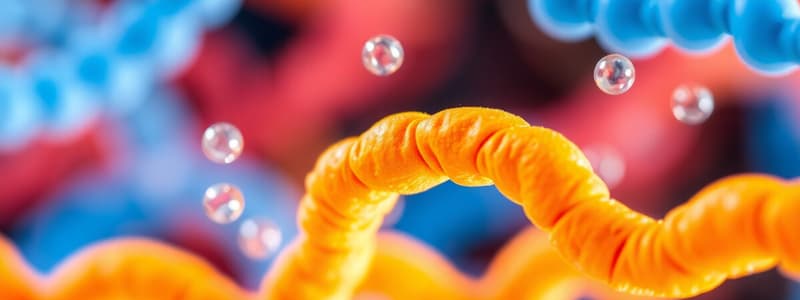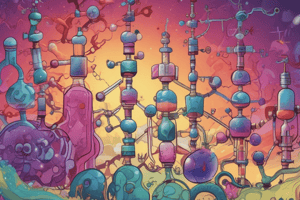Podcast
Questions and Answers
What characterizes the buffering capacity of an amino acid?
What characterizes the buffering capacity of an amino acid?
- Its ability to maintain a stable pH under varying conditions (correct)
- The exclusive ability to donate protons at low pH levels
- The pH at which it forms a zwitterion
- The ability to accept protons only at high pH levels
At which pH do amino acids typically exist as zwitterions?
At which pH do amino acids typically exist as zwitterions?
- At high pH where they are negatively charged
- At the isoelectric point, which is always above 7
- Around neutral pH, specifically around 7 (correct)
- At low pH where they are positively charged
What role do the side chains (R groups) of amino acids play?
What role do the side chains (R groups) of amino acids play?
- They influence the overall length of the protein chain
- They determine the molecular weight of the amino acids
- They dictate the amino acids' solubility and interaction with water (correct)
- They are solely responsible for the charge of the amino acid
Which statement about the isoelectric point (pI) of an amino acid is true?
Which statement about the isoelectric point (pI) of an amino acid is true?
In what manner does the primary structure of a protein influence its function?
In what manner does the primary structure of a protein influence its function?
Flashcards are hidden until you start studying
Study Notes
Amino Acids and the Role of pH
- Amino acids are fundamental units of proteins, each composed of an amino group (-NH2), a carboxyl group (-COOH), a hydrogen atom, and a unique side chain (R group) attached to a central alpha carbon.
- Classification of amino acids is based on the characteristics of their side chains:
- Nonpolar (hydrophobic): e.g., glycine, alanine, repel water.
- Polar (hydrophilic): e.g., serine, threonine, attract water.
- Acidic: e.g., aspartic acid, glutamic acid, contain extra carboxyl groups.
- Basic: e.g., lysine, arginine, contain additional amino groups.
- Amino acids can have different ionization states influenced by pH:
- Low pH (acidic): amino acids are fully protonated, carrying a positive charge.
- High pH (basic): amino acids lose protons, resulting in a negative charge.
- Neutral pH (around 7): amino acids coexist as zwitterions, possessing both positive and negative charges but are overall neutral.
- Each amino acid has a distinct pKa, indicating the pH at which 50% of the molecules are ionized.
- The buffering capacity of amino acids is crucial for maintaining pH balance in biological systems, as small pH changes can alter protein structure and function.
- The isoelectric point (pI) is the pH at which an amino acid has no net charge, essential for protein purification techniques.
Protein Structure
- Proteins are large biomolecules formed from chains of amino acids, their function being closely tied to their structure organized into four levels:
- Primary Structure: Linear sequence of amino acids, dictated by genetic information, crucial for determining folding and function.
- Secondary Structure: Local folding patterns (alpha helices and beta sheets) stabilized by hydrogen bonds.
- Tertiary Structure: Three-dimensional conformation resulting from interactions among side chains, dictating biological activity.
- Quaternary Structure: Some proteins are composed of multiple polypeptide chains (subunits) functioning together, as seen in hemoglobin.
- Proteins are categorized into:
- Fibrous Proteins: Long, insoluble proteins that provide structural support (e.g., collagen, keratin).
- Globular Proteins: Compact, soluble proteins with dynamic roles (e.g., enzymes like hemoglobin, myoglobin).
- Protein folding is a regulated process facilitated by chaperone proteins, preventing misfolding or aggregation.
- Denaturation causes loss of protein structure and function from heat, pH changes, or chemicals, often irreversibly, linked to diseases such as Alzheimer’s and Parkinson’s.
- Post-translational modifications affect protein function:
- Phosphorylation: Addition of phosphate groups regulating enzyme activity.
- Glycosylation: Addition of carbohydrates for stability and recognition.
- Proteolysis: Protein cleavage to activate or deactivate function.
Protein Function
- Proteins perform various essential functions:
- Enzymes: Catalyze biochemical reactions.
- Structural Proteins: Provide cellular support and shape (e.g., collagen in connective tissue).
- Transport Proteins: Facilitate molecule movement across membranes (e.g., hemoglobin transports oxygen).
- Hormonal Proteins: Regulate physiological processes (e.g., insulin).
- Defense Proteins: Protect the body (e.g., antibodies).
Enzymes and Catalysis
- Enzymes are biological catalysts that accelerate chemical reactions by reducing activation energy, without altering reaction equilibrium.
- Active Site: The specific region where substrates bind and transform.
- Lock-and-key model: Substrate fits perfectly into the active site.
- Induced-fit model: Enzyme changes shape to better fit the substrate upon binding.
- Enzyme specificity leads to catalysis of specific reactions or substrates, driven by precise interactions at the active site.
- Cofactors and coenzymes assist in catalytic activity:
- Cofactors: Non-protein factors (often metal ions like Zn²⁺ or Mg²⁺).
- Coenzymes: Organic molecules, often from vitamins (e.g., NAD⁺, FAD), essential for group transfer between molecules.
Factors Affecting Enzyme Activity
- Influences on enzyme activity include:
- Substrate concentration: Reaction velocity increases with substrate concentration until the enzyme is saturated (Vmax).
- Temperature: Increased temperature raises reaction rates until denaturation occurs.
- pH: Each enzyme has an optimal pH for maximum efficiency; deviations affect active site ionization.
- Enzyme inhibitors decrease activity:
- Competitive inhibitors: Bind active site; effects can be overcome by increasing substrate concentration.
- Noncompetitive inhibitors: Bind allosteric sites; reduce activity without altering substrate binding.
- Uncompetitive inhibitors: Bind to the enzyme-substrate complex, lowering both Vmax and Km.
Regulation of Enzyme Activity
- Enzyme activities are finely regulated through:
- Allosteric regulation: Effectors bind non-active sites to influence enzyme shape and function.
- Covalent modification: Regulation through reversible modifications like phosphorylation/dephosphorylation.
- Feedback inhibition: End product inhibits an upstream enzyme to control metabolic flow.
- Proteolytic cleavage: Activation through cleavage of inactive enzyme precursors (zymogens).
Clinical Relevance of Enzymes
- Enzyme levels in blood serve as diagnostic indicators for diseases:
- Elevated creatine kinase (CK) signifies muscle damage, including heart attacks.
- Enzymes like lactate dehydrogenase (LDH) and alanine aminotransferase (ALT) indicate liver and tissue damage.
Studying That Suits You
Use AI to generate personalized quizzes and flashcards to suit your learning preferences.




